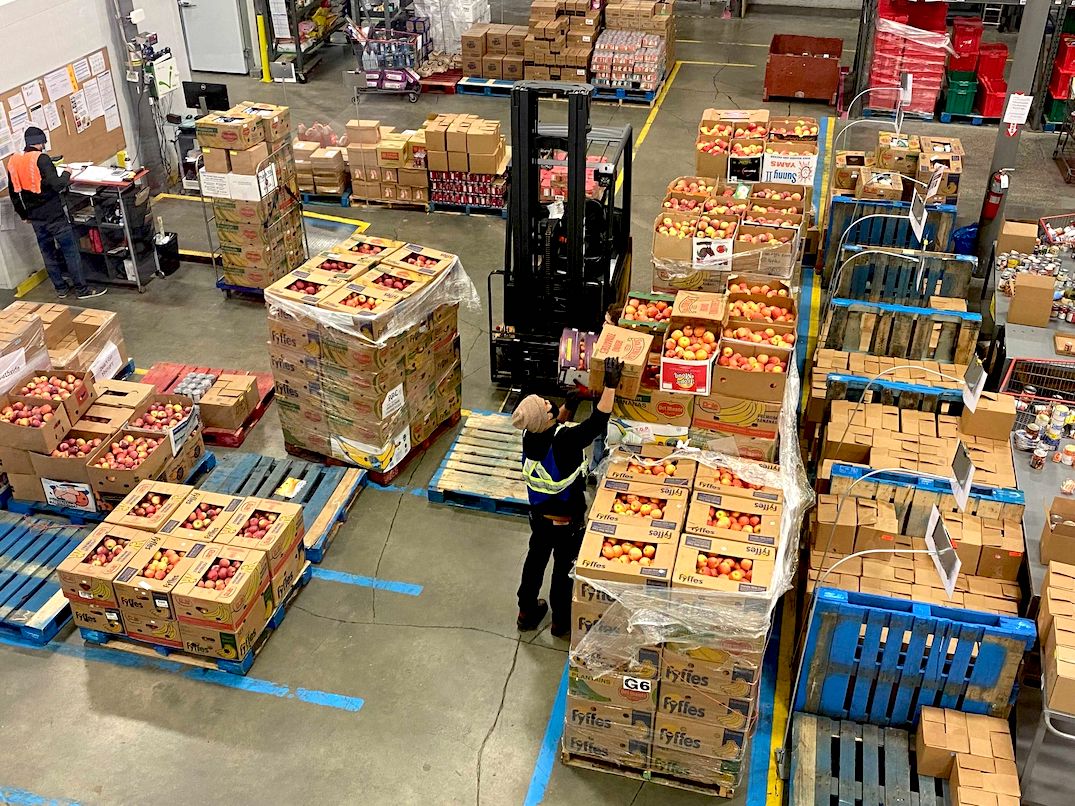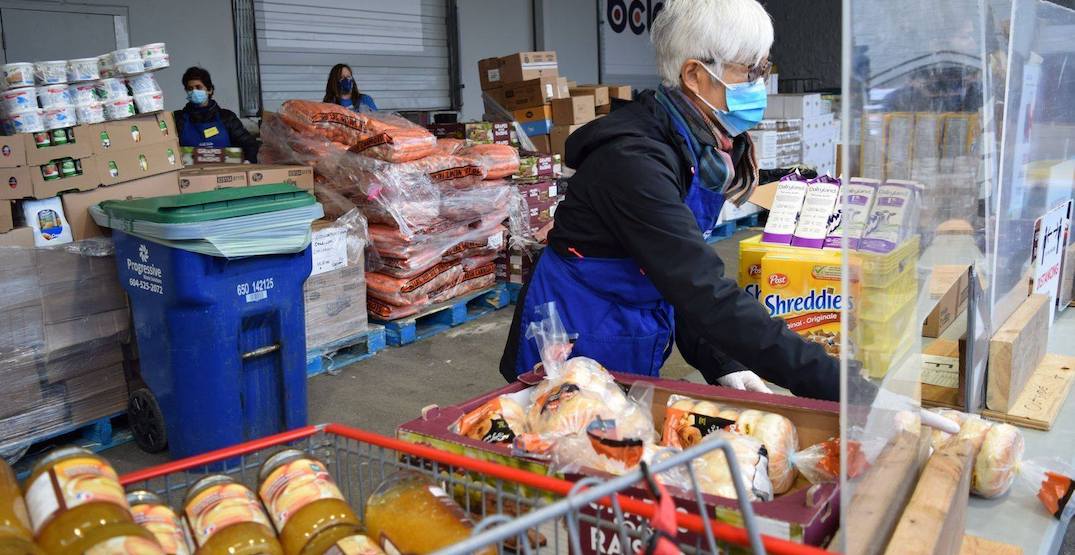Food bank left waiting for city approvals for two new Vancouver distribution hubs

Businesses, arts organizations, and residential developers have long lamented the costly delays as a direct result of the City of Vancouver’s slow-moving and archaic permitting processes. This is certainly far from being a secret.
But not even the Greater Vancouver Food Bank (GVFB) is spared, as it has two food distribution hubs currently caught up in the municipal government’s permitting department.
- See also:
Since October 2020, GVFB has been able to secure the lease of two locations at 1428 Charles Street and 1405 Thornton Street, which are separate industrial locations in and near the False Creek Flats.
For the Charles Street site, this is a temporary 10,000 sq ft space offered for free by LowTide Properties, which needs the space back in June 2021 as they have other plans for the property.
LowTide Properties had intended to apply for a development permit application on behalf of the food bank, but during the pre-application stage a city building inspector had mandated four conditions for compliance.

Temporary Greater Vancouver Food Bank distribution hub at 1425 Charles Street, Vancouver. (Google Maps)
“We reached out to the city and Mayor’s office, and then got booted down to the city staff level again, which is the source of all of our problems,” Cynthia Boulter, the Chief Operating Officer of the GVFB, told Daily Hive Urbanized in an interview.
“They are now looking into it, and they’re now saying they’re not sure where these conditions came from, so it’s a bit of a gong show. We need our development permit for wherever we distribute food. In any building we find, we’ll need to apply to the City of Vancouver for a permit.”
City staff told the landlord that the food bank would have to hand out food distribution paper schedules throughout the neighbourhood, but Boulter said this did not make any sense as their operating hours are very fluid, and they have no desire to spend on the cost of printing flyers that would be outdated in weeks.
They were also instructed to install a portable washroom, which they also have no plans in doing given the costs and maintenance required.
“They are taking down porta potties in some places in the city in some places because people are setting fires to them, so I’m not sure why they’d want us to maintain that,” she said.
Additionally, as the Charles Street distribution hub is open to the general public as a walk-in location, city staff asked the food bank to create a unique line management and security plan for the location, even though they already developed these strategies earlier in the pandemic.
Without receiving any permit from the city, the food bank opened at the Charles Street site anyway and has been distributing food to thousands of people, operating four to five days every week. So far, the municipal government has not shut them down at this location.

Greater Vancouver Food Bank’s future warehouse and community organization distribution hub at 1405 Thornton Street, Vancouver. (Google Maps)
As for the Thornton Street location, which was previously Greyhound’s bus depot, the food bank has been paying rent for the property since October 2020. The challenges presented by the municipal government for this site are described as a whole different nightmare for the food bank.
The original development application for the Thornton Street site proposing some relatively light renovations — such as the installation of a refrigeration unit — was submitted on September 16, 2020. But over the subsequent weeks, city staff mandated additional renovation requirements given that the property was on a flood plain.
“This created a host of new costs and work for the refrigeration we needed to put in for food distribution, connected to flooring and what could be installed where,” said Boulter.
The Thornton Street site was initially intended to be a distribution hub for both the general public and community organizations. Its location is also suitable for the general public, given the close proximity to SkyTrain Main Street-Science World Station and a number of major bus routes.

Greater Vancouver Food Bank warehouse and distribution hub at 8345 Winston Street, Burnaby. (Greater Vancouver Food Bank)
However, the challenges with the proposed renovations contributed to the GVFB’s downgrade decision to focus on turning the site into a warehouse and pick-up hub for the vans and trucks of the 95 community organizations the food bank works with.
Boulter says the food bank could not deem major costly renovations to be a fiscally responsible decision for the charity, especially now that it only two years remaining in its 2.5-year lease for the Thornton Street site.
“As the costs quickly became double our budget and beyond, we had to reassess as it wasn’t going to be fiscally responsible for a charity to invest that much money in a building we didn’t own, with a shorter term lease,” she said.
The food bank asked city staff to stop their review in early December 2020 due to major changes in their plans as a result of the skyrocketing costs, and a forthcoming revised proposal submission with smaller refrigeration and warehouse-only uses.
But soon after, they found another major hurdle in their way.
The municipal government’s Food Policy Council (FPC) had inserted a clause that would fundamentally regulate how the food bank runs its business, overriding what the charity deems to be the best operational practices for its mandate.

Greater Vancouver Food Bank warehouse and distribution hub at 8345 Winston Street, Burnaby. (Greater Vancouver Food Bank)
The clause was eventually removed, as the food bank’s planned registration procedure changes — a low-income check in addition to a standard ID and verification of address within their catchment areas — set to begin on April 1, 2020 were never enacted due to the pandemic’s onset. But the FPC later wrote a letter to the food bank voicing their disapproval with the registration policies for community organizations.
“Somehow, the Food Policy Council has the power to have a clause injected into a building permit process? And a completely ill-informed one at that,” said Boulter.
“We are a private charity and don’t take direction from the City of Vancouver regarding our policies and procedures.”
If and when the Thornton Street site receives its permit approval, the required renovation work will take up another two months before the food bank is able to serve community organizations from the location.
With its free lease at the Charles Street site ending in early summer and the inability to use the Thornton Street site as a walk-in location for the general public, GVFB is now seeking assistance from developers and landlords who may be willing to offer a free one or two-year lease of a warehouse space between 5,000 sq ft and 10,000 sq ft.

Greater Vancouver Food Bank warehouse and distribution hub at 8345 Winston Street, Burnaby. (Greater Vancouver Food Bank)
In 2019, GVFB relocated its headquarters and main warehouse from Strathcona in Vancouver to a 37,000 sq ft space at 8345 Winston Street in Burnaby (near SkyTrain Production Way-University Station), owned by Beedie Group.
Beedie Group also provided the food bank with an additional warehouse to store food at a rental cost of only $1 per month. While it will need to vacate this extra space soon, the developer is looking at finding them a replacement space.
Boulter says 83 of the 95 community organizations currently supported by the food bank are located within Vancouver. But without the Thornton Street distribution hub, many of these organizations are now driving to this Central Burnaby location to pick up their food.
In a statement to Daily Hive Urbanized, Jessie Adcock, the city’s general manager of development, buildings, and licensing, said the city “is supportive of the Greater Vancouver Food Bank’s mission of providing healthy food to those in need.” City staff are now reviewing a revised application submitted last month for the Thornton Street.
For the Charles Street site, Adcock states “the city has asked the Food Bank to apply for permits for this location to ensure that health and safety standards are being met.”
NPA councillor Lisa Dominato, who reached out to the GVFB over the permitting issues, says her understanding is that city staff are now “working diligently to have the permit issued ASAP” for the Thornton Street site.
Dominato adds that she and NPA councillor Sarah Kirby-Yung are bringing forward a motion to city council to help address the backlog in permit applications and improve the processes to issue permits in a more timely way.
Early on in the pandemic, the food bank was able to set up in the Queen Elizabeth Theatre and Mount Pleasant Community Centre, but after a few months, they had to vacate the premises as the facilities were resuming some of their programming.

Greater Vancouver Food Bank warehouse and distribution hub at 8345 Winston Street, Burnaby. (Greater Vancouver Food Bank)
Over the past year, since the onset of the pandemic, GVFB has created a new program assisting community organizations using emergency pandemic funding from the federal government.
Boulter says the food bank added about 20 partners, such as churches and community centres. Each partner in this program received an industrial fridge and freezer, worth $10,000 combined, and a supply chain of food feeding up to 450 people every week.
“We’ve never had this federal money before and we thought, we wanted to get more food into the community. What if we ordered these agencies more food and somewhere to store it, as it is a bit of a challenge for them,” she said.
GVFB found success in this refrigeration program as it creates more effective miniature distribution hubs in neighbourhoods, shortening the distance for people who may not be able to travel to one of the food bank-operated distribution hubs, such as the Charles Street site.
“All of these agencies receive the same menu that we distribute to our clients each week. It means seniors and people with mobility issues potentially have somewhere closer to go,” said Boulter.

Warehouse of the Greater Vancouver Food Bank. (Greater Vancouver Food Bank)
The food bank has also eliminated its waitlist for community organizations to receive food support, and performed targeted outreach in areas where they previously did not have a strong coverage, including adding several organizations in South Vancouver and the West End.
A major partner that was added is a church located at the University of British Columbia, where about 15,000 lb of food has been supplied on a weekly basis, supporting a large number of struggling international students who remained on-campus during the pandemic.
“The international student community was literally starving from their parents not having any work,” she said.
Boulter notes that this strategic shift towards boosting GVFB’s work with community organizations is partially due to the drop in demand from the walk-in general public at food bank-operated distribution hubs.
“Our demand trends have been closely following what many food banks have seen over the past year. Our numbers were down initially from people staying home, then they started coming back later in 2020. But they didn’t return to pre-pandemic levels in person,” she said.
Boulter believes the federal government’s Canada Emergency Response Benefit (CERB) made a difference during the worse of the economic hardships, allowing people to buy food in a way that they could not pre-pandemic, and rely less on food bank services.
The dip in walk-in general public demand has been more than offset by the increase in GVFB’s support for community organizations. They have increased the total amount of monthly food supply going out to people in need from 450,000 lb before the pandemic to about 650,000 lb right now.

